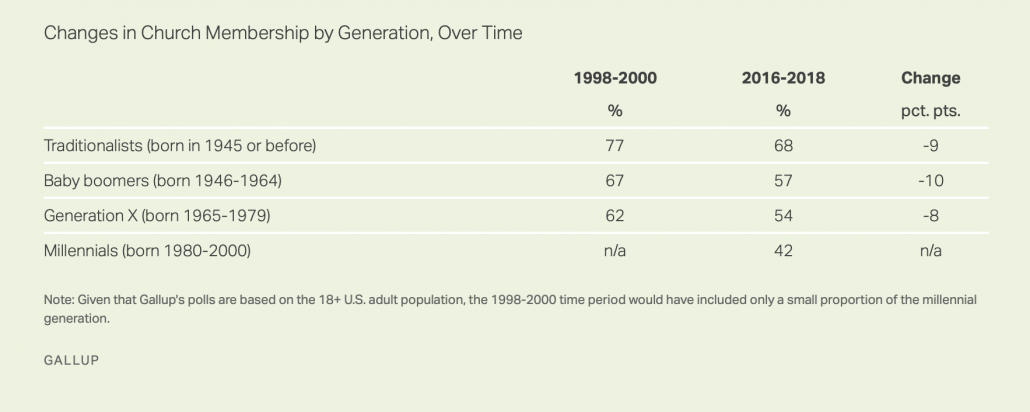Christian churches are facing a unique challenge to address weakening membership which has steadily declined over the last 20 years (Gallup, 2019). The ongoing concern within the religious Christian community is that millennials are the problem. The millennial generation is perceived as the least connected to religion and church (Puffer, 2017). According to a 2019 Gallup study, only 57% of millennials who identify as Christians belong to a church. This is more than a 10-point decline as compared to the 68% of Generation X Christians who belonged to a church when they were roughly the same age (Gallup, 2019). A lack of millennial participation in the church infers a dying church. Without the younger generation taking a more active role in membership, there is fear that traditional churches may cease to exist in the near future.

Researchers who study young adult religious engagement have attributed several factors to this decline including generational disparities, varying religious engagement throughout the life cycle, a national trend towards a lack of religious affiliation and secularization by means of exposure to higher education (Hayward, 2013; Jacobs, 2019; Van Ingen, 2015). The Gallup report summarizes the religious trends of adults in the United States this way:
Religiosity plummets after age 18, coincident with young people leaving home and heading out into the real world of work or college. Then, religiosity begins to rise again as young people go through their 30s, coincident what marriage, children and more stable involvement in specific communities. Religiosity generally continues to rise with age.
(Newport, 2019)
While these factors may certainly play a role in the decline of millennial church attendance there are several gaps in the literature.
While survey research indicates millennial in-person church attendance is declining, there is a gap in the literatures as to how millennials may be using technology to engage in their faith practices. Similar to how traditional in-person learning environments have extended to online learning beyond the classroom, such is the case with faith learning extending beyond the church walls. To suggest that church attendance is the only measure of church membership or faith engagement, as some previous studies have reported, may be overlooking other avenues individuals use to access religious teachings.
I hope to have more to contribute to this conversation (after I finish my dissertation). For now, check out this podcast where I join Lisa Smith of Convergence in Alexandria, VA as part of their Gather Series: re-imagining worship and gathering well in soulful community.
Episode 8: Gather: Lindsay Hayes on Technology & Faith Among Millennials
Puffer, K. (2017). Protestant Millennials, Religious Doubt, & the Local Church. Religions, 9(1), 8.
Jacobs, D., Tilstra, D., Benjamin, F., Pittman, S., James, H., Thayer, J., … & Tyler, C. (2019). Adventist Millennials: Measuring Emerging Adults’ Connection to Church. Review of Religious Research, 61(1), 39-56.
Van Ingen, E., & Moor, N. (2015). Explanations of changes in church attendance between 1970 and 2009. Social science research, 52, 558-569.